On Friday, April 8, Events Editor Ava Slocum attended the opening matinee of the Columbia Musical Theater Society’s presentation of Rodgers and Hammerstein’s Cinderella, running April 8 and 9 in the Glicker-Milstein Theatre.
The story of Cinderella is famously glittery, filled with magic and beauty and dreams-come-true. CMTS’s rendition of Rodgers and Hammerstein’s 1957 Cinderella musical conveys all the sparkly fantasy of the fairy tale, with added elements of kingdom politics, revolution, and sisterly bonds that make for a gratifyingly complex presentation of the classic story.
Besides having listened to the soundtrack, before attending CMTS’s production, I wasn’t extremely familiar with the Rodgers and Hammerstein version of the Cinderella story (written in 1957 and originally broadcasted as a live TV movie starring Julie Andrews). Sitting in the audience, I thought the story seemed different from what rudimentary knowledge I had about the Julie Andrews version and the 1997 Brandy Norwood remake–according to the program, CMTS’s production uses a new book by Douglas Carter Beane from 2013.
The new version makes several changes to the original Cinderella framework, all of which, to my mind, were welcome. Cinderella’s fairy godmother no longer pops out of the woodwork in Cinderella’s hour of need, but takes the form of an old village woman, “Crazy Marie,” who receives kindness and support from Cinderella before revealing her identity. A new character, Jean-Michel, is a political revolutionary and a love interest for Cinderella’s stepsister Gabrielle, and the dashing Prince Topher, like Cinderella, is an orphan, and insecure in his new role of leadership.
Vincent Snyder CC ’24 did a wonderful job of conveying the prince’s uncertainty as he adapts to the responsibilities of running a country amid pressure from other people at court. His character’s song, “Me, Who Am I?” with its sense of “what am I doing with my life?” earned many knowing chuckles from the audience. Meanwhile, Is Perlman CC ’25 played a fantastically conniving Sebastian, the prince’s self-serving advisor and the stepmother’s co-conspirator in her plan to marry one of her daughters to the prince.
Of course, the prince’s life changes dramatically for the better when he meets his Cinderella. I thought it was interesting that the musical added the angle of Cinderella helping the prince, rather than solely focusing on her as the one in need of rescue. However, before Cinderella makes it to the ball, she must first have her rags and pumpkin transformed into a beautiful gown and carriage, which she and her fairy godmother Marie accomplish with a lovely rendition of the catchy song “Impossible.” Abigail Ganz BC ’24 was delightful and funny as the crazy old woman-turned fabulous fairy. In the titular role of Ella, Samantha Seiff CC ’22.5, was a true standout, believably playing a kind, compassionate Cinderella, and performing Cinderella’s best-known songs “In My Own Little Corner,” “Ten Minutes Ago,” and “A Lovely Night,” with a gorgeous singing voice worthy of any princess.
In both the musical’s original version and Douglas Carter Beane’s rearrangement, Cinderella sings the songs “When You’re Driving Through the Moonlight” and “A Lovely Night” the morning after the ball, when she reminisces on her dance with the prince while the stepmother and stepsisters lament over the mysterious woman who pulled the prince’s attention away from every other woman there.
The stepmother played by Jude Poley, BC ’23 was a fairly traditional interpretation of the character, in that she spent the musical deriding Cinderella, demanding that she do chores, and keeping her from going to the ball with her stepsisters. However, this new version depicts the two stepsisters in such a way that purposely avoids any cruelty on their part toward Cinderella, presenting them instead as kind girls who could have easily been friends with their cinder-covered sister if not for their mother’s insistence that they stay separate. This change in the stepsisters’ characters–which I thought both Beane’s rewrite and CMTS’s interpretation of it accomplished believably and meaningfully–comes across most clearly in the “A Lovely Night” scene, when Cinderella and her stepsisters dance gleefully around the stage together as they recreate the ball of the night before, with even the stepmother joining in on the fun.
Lilly Gasterland-Gustafsson BC ’25 was equally hilarious and heart-rending as Charlotte, the stepmother’s dowdy, awkward daughter who gets to sing the “Stepsister’s Lament,” right after the ball, decrying the prince’s choice of skinny, classically beautiful Cinderella over “a usual girl like me.” Sadie Klaus BC ’23 played the other sister Gabrielle, who falls in love not with the prince but with Jean-Michel (who, for his own part, spends most of the show trying to get Prince Topher to listen to his ideas for political reform). After “A Lovely Night” and Cinderella’s suspiciously accurate descriptions of the ball, palace, and prince, it is Gabrielle who discovers Cinderella’s secret… but rather than telling her mother and sister that Cinderella was the unknown woman at the ball, she promises to keep quiet, while Cinderella reaffirms her support of Gabrielle and Jean-Michel’s secret romance.
I got a little teary when Gabrielle and Cinderella hugged after redefining themselves as true “sisters” to each other. Of all the updates and additions that CMTS’s Cinderella production included, the reworking of the Cinderella-stepsisters relationship was my favorite for its depiction of mutual sisterly empowerment and women supporting one another. Director Grace McCormick BC ’24 beautifully brought out this element of Beane’s revised script with the close attention paid to these scenes.
I also enjoyed Jean-Michel’s characterization and his commitment to his political ideals–however, the script’s explanation of what these ideals actually were came across as a bit fuzzy. In a scene when Cinderella introduces Jean-Michel and a group of angry townspeople to Prince Topher, Jean-Michel refers to the poor villagers having their homes taken away from them for some reason–other than that, the specifics of his political platform are pretty unclear. However, Jean-Michel, with his rabble-rising cry, “Now is the time! The time to act!” is an interesting and likable character, and Wesley Schmidt CC ’22 portrayed him with a mix of courageous activism and adorable shyness around his crush Gabrielle. The couple’s excitement was palpable in Act II as they danced off to volunteer together at the neighborhood soup kitchen for their first date.
All these threads of political idealism and various romances made the show feel a little plot-driven toward the end. However, having the framework of a story as well-known as Cinderella made it impossible for the story to stray too far off-course. And the music throughout was lovely and colorful, with the small live orchestra, led by music director Malcolm Toleno CC ’23, doing full justice to the Rodgers and Hammerstein score. The dancing, too, was fabulously ornate, with the elaborate waltz scenes from choreographers Annika Voorheis BC ’24 and Pimprenelle Behaeghel BC ’24 evoking the story’s magical, fairy-tale elements.
Despite the production’s many subplots, this emphasis on the glitter and sparkle that we traditionally associate with the Cinderella story seemed to be one of McCormick’s main focuses in her direction of the musical as her program note invites audience members to “fall back into your childhood.” This may not be the most original take, but if creating a conventional fairy-tale atmosphere is the goal, CMTS’s production succeeds with its appropriately Disney-esque colorful costumes and spectacular song-and-dance choreography. However, I found the rather plain set to be lackluster compared to the beauty and attention to detail in most other aspects of the show. Meanwhile, the plot elements in the show that the new script introduces succeed in adding depth to the glitz and glamor of the story without feeling overly contrived.
Overall, a true sense of collaboration between the director, cast, and crew came across in every aspect of CMTS’s production; the hard work of everyone involved was clear in everything from the dancing to the music to the beautifully designed ball gowns courtesy of costume designer Chambit Miller, CC ’24. “I have always been fascinated with how we can use magic to represent the truth behind human connection,” McCormick explains in her director’s note, an element that is very apparent in her direction of this musical take on the traditional story. After all, “without the personal connections that Cinderella makes through the show, she would not have been able to be the kind person she truly is at heart.” CMTS’s Cinderella succeeds beautifully as an examination of kindness and the relationships between people, emphasizing the story’s personal bonds as the real factor behind its magic.
CMTS’s Cinderella will run for two more performances on April 9 at 2 pm and 7 pm. Tickets are sold out online, but a few will be made available at the door for both performances (just make sure to get there early, since space in the GMT is limited!). Standby tickets will be given out first come first served.
All images via Ava Slocum
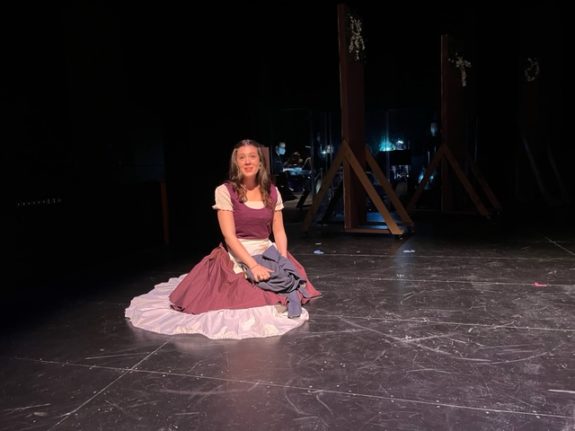
“In my own little corner, in my own little chair…” 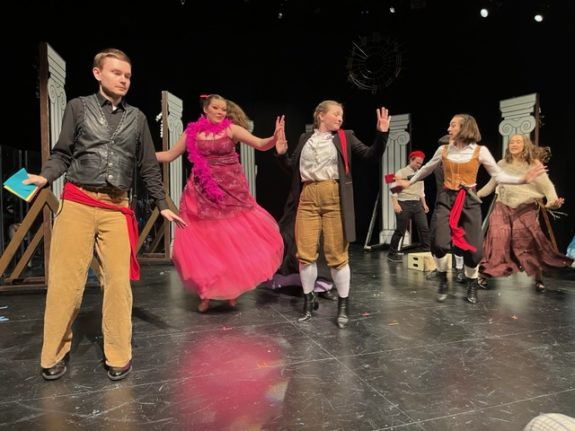
“The prince is giving a ball!” dance, Act I 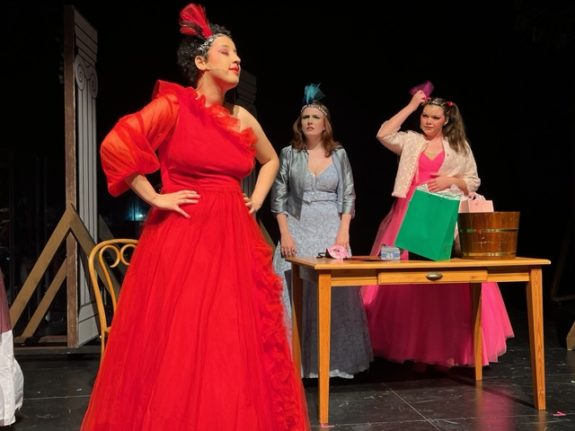
Stepmother and stepsisters 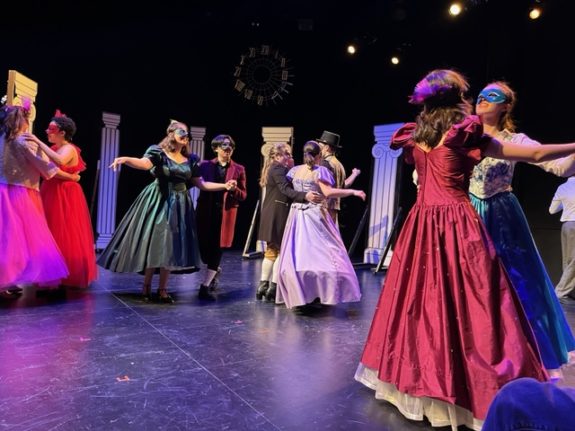
The magical ball scene 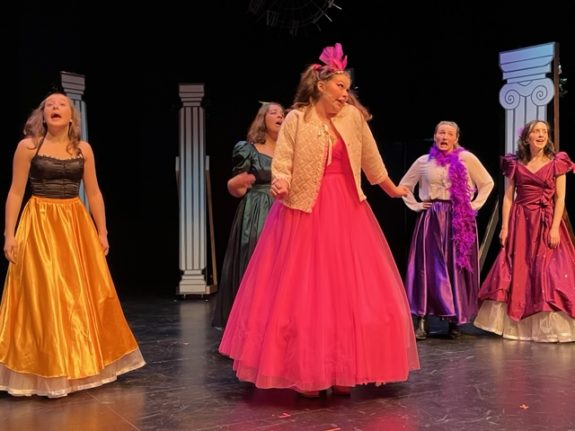
“Stepsister’s Lament” 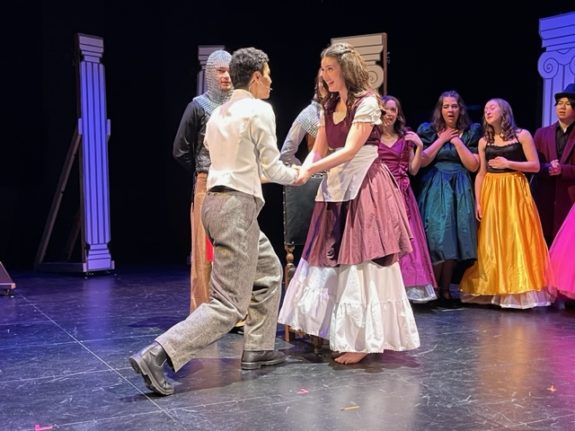
Happily ever after!


 0 Comments
0 Comments